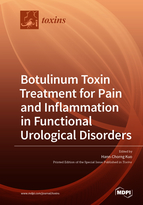Botulinum Toxin Treatment for Pain and Inflammation in Functional Urological Disorders
A special issue of Toxins (ISSN 2072-6651). This special issue belongs to the section "Bacterial Toxins".
Deadline for manuscript submissions: closed (31 December 2019) | Viewed by 50358
Special Issue Editor
Interests: botulinum neurotoxin; neurourology; urodynamics; female urology; stress urinary; incontinence; LUTS
Special Issues, Collections and Topics in MDPI journals
Special Issue Information
Dear Colleagues,
The botulinum toxin has been widely applied in the treatment of functional urological diseases, such as overactive bladder, neurogenic detrusor overactivity, interstitial cystitis, and chronic pelvic pain syndrome. Evidence has shown that the botulinum toxin not only affects the release of neuropeptides from motor nerve endings, but also connects sensory nerve to the central nervous system. Inflammation in the central nervous system can be reduced after botulinum toxin treatment. The scope of therapeutic targets involves detrusor overactivity; sensory disorders; bladder pain and pelvic pain; and inflammatory disorders at the bladder, prostate, and bladder outlet. Although the actual pathophysiological mechanism of the action of the botulinum toxin has not been completely demonstrated, an anti-inflammation effect might be the predominant therapeutic mechanism for functional urological disorders such as an overactive bladder, bladder hypersensitivity, interstitial cystitis, chronic pelvic pain syndrome, chronic prostatitis, and lower urinary tract symptoms/benign prostatic hyperplasia. This Special Issue of Toxins will cover the therapeutic potentials of the botulinum toxin on lower urinary tract dysfunctions, with emphasis on the mechanism of pharmacological action and clinical effects. Review articles and original articles related to the theme of this Special Issue are welcome.
Prof. Hann-Chorng Kuo
Guest Editor
Manuscript Submission Information
Manuscripts should be submitted online at www.mdpi.com by registering and logging in to this website. Once you are registered, click here to go to the submission form. Manuscripts can be submitted until the deadline. All submissions that pass pre-check are peer-reviewed. Accepted papers will be published continuously in the journal (as soon as accepted) and will be listed together on the special issue website. Research articles, review articles as well as short communications are invited. For planned papers, a title and short abstract (about 100 words) can be sent to the Editorial Office for announcement on this website.
Submitted manuscripts should not have been published previously, nor be under consideration for publication elsewhere (except conference proceedings papers). All manuscripts are thoroughly refereed through a double-blind peer-review process. A guide for authors and other relevant information for submission of manuscripts is available on the Instructions for Authors page. Toxins is an international peer-reviewed open access monthly journal published by MDPI.
Please visit the Instructions for Authors page before submitting a manuscript. The Article Processing Charge (APC) for publication in this open access journal is 2700 CHF (Swiss Francs). Submitted papers should be well formatted and use good English. Authors may use MDPI's English editing service prior to publication or during author revisions.
Keywords
- Botulinum toxin
- Functional urological disorders
- Pain
- Inflammation
- Botulinum toxin treatment
- Overactive bladder
- Neurogenic detrusor overactivity
- Interstitial cystitis
- Chronic pelvic pain syndrome







